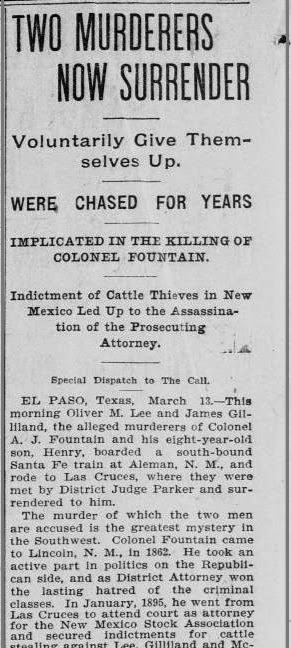For several years we've gathered historical information around Hillsboro, Lake Valley and Kingston, and it's oddly the latter where myths arose and persist. Most recently, New Mexico Magazine repeated these myths in a feature story.
Below is a collection of annotated primary sources that are listed in chronological order. Key dates to keep in mind: the east slope of the Black Range was prospected in the late 1870s; Kingston as a town came to life in late 1882. As a place name, it does not exist before August 1882. In 1893, the federal government changed its monetary policy and over night, the price of silver slumped, and the silver miners moved on.
We consider the information as either a "primary source," that is, information provided by a direct observation, or anecdotal, or a story passed along without direct observation (Ex: N.W. Chase's 1888 "Cornerstone" letter).
1882
Kingston is but two months old in this Las Vegas Daily Gazette story.
In October, the Lincoln County Leader reported 350 to 500 people in Kingston.
The Albuquerque Morning Journal reports 50 house built in a day; reporter speculates arrivals could go to 100 persons per day.
The Albuquerque Morning Journal reports only 45 men working in the mines in November.
An estimated 1,200 people are in Kingston in this Albuquerque Morning Journal story.
The Rio Grande Republican reports in November, an estimated 5,000 folks in Kingston.
A correspondent for the Engineering and Mining Journal documented his November 22 visit.
This December story notes 150 families in Kingston.
Kingston closes out the year with a party.
1883
This prospectus on Kingston was published in early 1883 by Kingston Tribune editor, Charles Greene. By the end of 1883, he had moved his newspaper to Deming.
The Black Range expected solid growth of Kingston and nearby Percha City.
1884
This McKinney business gazetteer covers Hillsboro and Lake Valley businesses, but Kingston is curiously absent. It's awkward to use, but go to page 1456.
1885
At the often reported height of Kingston's activities and population, this 1885 business journal reveals only 300 people in Kingston, jibing with the 1885 Territorial census that counted 329 people in Kingston and outlying Danville camp. This journal provides an invaluable look at town business, listing names and occupations. Go to page 322, but look elsewhere therein for more details on our area.
1887
Where was President Cleveland when a prankster signed his name on the Victorio Hotel register?
Kingston town plat survey conducted by the General Land Office.
George Rowell's newspaper directory shows the Shaft serving a Kingston population of 725.
1888
The Gospel in All Lands documents 1,000 people in Kingston, a narrative from Rev. N.W. Chase.
Rev. N.W. Chase penned a letter in 1888 for the cornerstone of the Kingston church, and cites that Kingston had 3,000 people a few years earlier. The original letter (no scan available) is in the Methodist archives in Albuquerque, and a copy is kept at the Black Range Museum.
1890
The U.S. Census Bureau documents 633 people living in Kingston and 816 in the mining district; 37 Chinese people lived in Sierra County (less than 400 over the entire territory).
1891
The Territorial Bureau of Immigration documents a population of 5,132 in Sierra County.
The American Newspaper Directory reveals that the Shaft served a Kingston population of 1,500.
1893
The country falls into an economic depression; silver prices slump and Kingston miners leave.
1894
The Territorial Bureau of Immigration documents a population of 1,000 in Kingston.
1895
Kingston fails to show up on maps and atlases until the early 1890s. It's on this Rand McNally published 1895.
1904
This February 26, 1904 article from the Silver City Enterprise was misquoted in a story in the Hillsboro Historical Society's newsletter, December 2014. The 1904 article states that Kingston had a population of 5,000 in the 1880s. The newsletter article characterized this Enterprise story as there being that many living in Kingston in 1904.
1907
History of New Mexico by George Anderson has Kingston at 1,800 people in 1882.
1913
The El Paso Herald reported that Kingston had a population of 2,000 in the early 1880s.
1919
Hearst's magazine reports that Kingston swelled to 6,000 people in the early 1880s.
1935
New Mexico magazine states that Kingston had 1,500 residents (see Facebook cite below).
1936
Black Range Tales says that 7,000 people lived in Kingston.
 |
| Silver City Enterprise 2/26/04 (part 1) |
 |
| Silver City Enterprise 2/26/04 (part 2) |
You can find more documentation, census records and newspaper directories, on the Hillsboro Historical Society's Facebook site in the "Photos" section.
You can read about the newspaper that tried to make a go of it in Kingston, in this previous post.
You should read beyond this arcana on the origins of Kingston's mythic population, and check out what some of the territory's newspapers were saying about the area for yourself. You won't be disappointed. You'll read about the comings and going of folks, the values of the mines, the business successes and failures and an occasional killing. You can read about the newspaper that set up shop under a tree, a photo of which was in the most recent HHS newsletter. That press wasn't Kingston's first. You'll read what the observers saw and thought at the time--and how lucky we are to have that available to us.
 |
| Kingston, 1890, Starr Peak is visible to the east. Black Range Museum. |


















